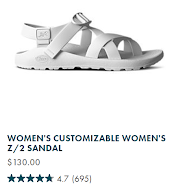Chacos: Price as an Indicator of Value
It's known that price depends on the product, brand, materials, and other factors. There are many different kinds of pricing strategies, each with different benefits and draw backs. When evaluating price form a consumer's standpoint, price, "is often used to indicate value when it is compared with perceived benefits" (Kerin). Because marketers know this phenomenon, they make sure to market the benefits of the good or service to consumers so they are able to make a value assessment on it.
In the case of Chaco Footwear, a popular retailer of shoes and gear for use in the outdoors, marketing the benefits of their products is crucial to convincing consumers to pay relatively high prices for their products. Chaco specializes in durable, adjustable footwear, with the majority of styles targeted to water or mountain wear. That being said, they do have some products for daily city use.
With their signature styles ranging from $95-$130, Chaco is banking on the perceived benefits of the shoe to outweigh the higher cost, thus creating more value in the eye of the consumer. When evaluating their website, ads, and branding, it is clear that their best sellers are the multi-purpose, waterproof styles. This is largely due to the perception that there are more benefits to this style. The toe loop style is water-proof, easily washable, durable, can be converted to no toe loop, and the colors are customizable. Overall, they are sand and dirt friendly because the rubber sole is easily cleaned and the straps can be scrubbed clean.
With their signature styles ranging from $95-$130, Chaco is banking on the perceived benefits of the shoe to outweigh the higher cost, thus creating more value in the eye of the consumer. When evaluating their website, ads, and branding, it is clear that their best sellers are the multi-purpose, waterproof styles. This is largely due to the perception that there are more benefits to this style. The toe loop style is water-proof, easily washable, durable, can be converted to no toe loop, and the colors are customizable. Overall, they are sand and dirt friendly because the rubber sole is easily cleaned and the straps can be scrubbed clean.
These benefits are compared to their leather styles, which do not have customization, are not water proof, and are not easily cleaned.
Considering that the standard leather styles are more expensive than the non-customizable, standard rubber styles, but have less benefits, consumers view them as having less value. It's because of this that the rubber styles are the best sellers, as listed on the website, and are what Chaco is known for. This is not to say that the leather styles aren't popular, they just have less value in the eyes of consumers.
Pivoting in their approach, the brand has launched Chaco Chillos, which are slip on shoes with zig-zagging straps across the toe and foot. The Chillos retail for around $50, which is about half of the retail price of the original style. Chillos are aimed at more casual consumers, but they still have the same durable, cleanable, material. This is an interesting approach, because one may think they would have expanded their leather line to a more casual market. Instead, Chaco went off of the success of their original shoe and made it more affordable. Although this shoe has less perceived benefits, the price is lower, which keeps the value roughly the same. Needless to say, the Chillo are one of their best sellers online as well. Had Chaco kept the price around $95-$130 for the Chillo but removed some of the perceived benefits, the perceived value in the eyes of consumers would have decreased, ultimately leading to lower success.
Chaco is a good example of a brand being aware of what makes their product sell and knowing what their consumers are looking for. Because value = perceived benefits / price, Chaco's was able to maintain value despite adjusting the perceived benefits, by just adjusting the price at which their products sell.
Works Cited
Kerin, Roger A., and Steven W. Hartley. Marketing: the Core. McGraw-Hill Education, 2019.






Comments
Post a Comment